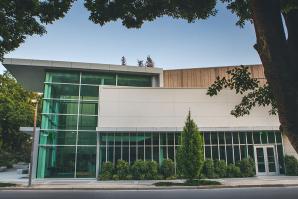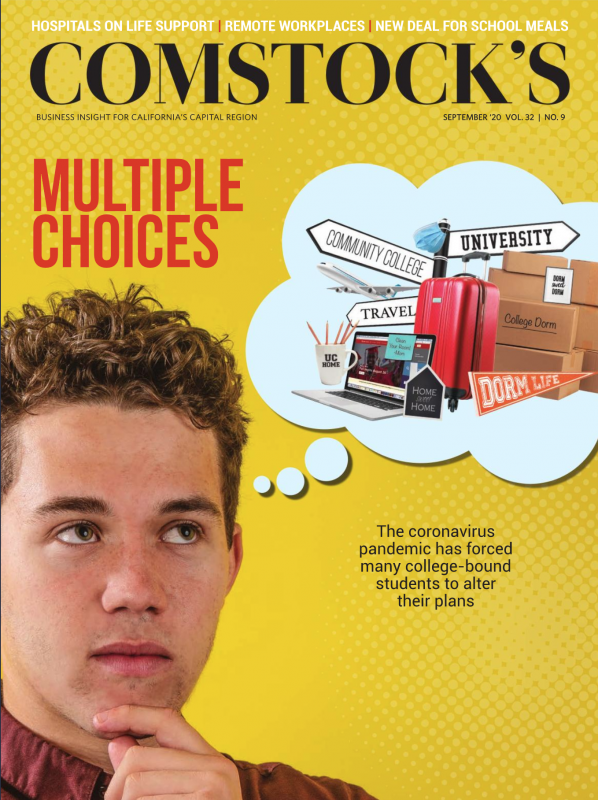Liam Graf was set to attend UC Riverside this fall. The graduate from Whitney High School in Rocklin applied with an undeclared major and was hoping to find his path in the humanities or liberal arts. Then the coronavirus pandemic hit, and higher education moved mostly online. Suddenly, the first-year residential-college experience Graf was hoping for was in jeopardy.
“I was looking forward to the whole experience — the dorm rooms and meeting new people,” he says. “I feel it’s already a financial burden, so when the school said it was going to be primarily online, it just didn’t seem worth it to me.” Graf decided to stay in his hometown of Rocklin and attend Sierra College this summer, followed by a six-month study-abroad program at an international school in Germany. In August, Graf was notified that the international school he enrolled in postponed his program until January 2021. He regrouped again and reverted to his original plan of attending community college and enrolled in Sierra College for fall; he plans to reapply to UC Riverside for the 2021-22 academic year.
“I was looking forward to the whole experience — the dorm rooms and meeting new people. I feel it’s already a financial burden, so when the school said it was going to be primarily online, it just didn’t seem worth it to me.”
LIAM GRAF WHITNEY HIGH SCHOOL, 2020 GRADUATE
With remote learning continuing into the fall for many four-year colleges and universities, and countless unknowns surrounding on-campus and residential services, 2020 high school graduates are reassessing their first-year college plans. Now these students are weighing all the options, including staying home for community college, learning online at a four-year college, postponing college altogether and taking a gap year, or studying internationally. While Graf initially hadn’t considered going abroad, the international school promised the on-campus experience he was hoping for with a mixture of in-person and online classes. When that was delayed, community college seemed the prudent choice. “All these changes have been really hard and made it almost impossible to plan,” he says.
With students reconsidering their options, Sacramento-area community colleges have also seen a significant increase in applications and enrollment for classes, starting with the summer 2020 session. Willy Duncan, president of Sierra College, estimates that summer enrollment increased approximately 20 percent from the same period last year; fall enrollment was heavy as well, with a big spike during the first few weeks that leveled off with about a month remaining. The Los Rios Community College District, which includes American River College, Cosumnes River College, Folsom Lake College and Sacramento City College, also experienced a substantial increase in demand for summer and expects fall to be slightly higher, according to Brian King, the district’s chancellor (and a member of Comstock’s Editorial Advisory Board).
Even before the move to remote learning, both Sierra College and Los Rios had at least 20 percent of their courses online, which King believes gives community colleges an advantage. “We already had a substantial number of courses being taught online before the pandemic,” he says, “so that made the shift somewhat easier.”
Four-year colleges and universities are considering a variety of academic options — from fully online to fully in person and everything in between — which continue to shift as public health information about the coronavirus pandemic continues to evolve. California State University, the largest four-year college system in the country, announced in May that it would be canceling most in-person classes for the fall, moving primarily to online instruction. The University of California announced similar plans in June and will offer the vast majority of classes virtually.
UC Davis Enrollment Jumps
Before the coronavirus hit the U.S., UC Davis anticipated that enrollment might be light for the fall. “We had an inclination about the pandemic early on — even in January and February, internationally — and needed to look forward to see how that might impact our numbers,” says Don Hunt, associate vice chancellor for enrollment management for UC Davis. “You know your historical norms and your track record. If you haven’t shifted anything, there’s not likely going to be a significant change in numbers. But if there is an environmental shift, that could have an impact.”
In response to the pandemic and the shift to remote learning, UC Davis offered admission to a record number of freshman and transfer students for fall 2020, opening up the opportunity for more students to accept admission to a campus in the competitive UC system. The number of students admitted to UC Davis for undergraduate study — 45,820 out of 94,763 that applied — is a 13.6 percent increase over last year. A larger than average number of students were offered admission off the UC Davis waitlist; 4,300 students for fall 2020 versus 2,500 last year, a 72 percent increase from fall 2019. “We went in more heartily than in the past,” says Hunt. “We didn’t want to have people wonder. They were already facing enough uncertainty, so we wanted to remove as much of that as possible.”
Arya Gupta was one of those students facing uncertainty. The Fremont native applied to seven of the nine UC undergraduate campuses, along with a handful of state schools and private universities. In the UC system, he was accepted to UC Irvine and UC Santa Cruz and waitlisted at UC Davis. He had decided to go to UC Irvine, then got a notice that he was accepted at UC Davis. His family was particularly excited, he says, because the campus is only a two-hour drive from his home. The applied math major hopes to pursue a career in data science and says UC Davis has a great program for that field. Even though most of his fall classes are scheduled to be online, Gupta has no plans to delay his college career. After an academic stumble in his junior year of high school, the incoming freshman has a renewed focus. “I’m looking forward to working hard in college to prove to myself that I can do it, and I don’t want to put that off,” he says.
UC Davis’ strategy to boost admission appears to have paid off. It estimates it will enroll about 9,500 new freshmen and transfer students this fall, a planned increase of about 5 percent from fall 2019. “California has always had too many students to meet demand,” says Hunt. “That coupled with the unemployment factor created a natural upward trend.” The overall freshman admission rate for fall 2020 for the UC system was up by 8 percent.
Not all four-year universities in the Capital Region experienced increases. Sacramento State is expecting a small drop in enrollment — approximately 1 percent overall. It offered admission to slightly more students for fall 2020 compared to fall 2019, and did not put any students on its waitlist. “Given the COVID issues and what was going on in the K-12 districts, if students met our minimum requirements, we admitted them,” says Ed Mills, vice president of student affairs. Projected enrollment for new incoming students for University of the Pacific has remained relatively flat too, with 975 expected this year, compared to a little more than 1,000 in 2019.
Colleges intending to welcome students back to campus have added safety protocols that comply with public health guidelines, like mandatory use of face coverings, social distancing, one-way hallways, more intensive cleaning and sanitizing, and separate quarantine space for students who test positive for COVID-19. College drop-off — the all-day occasion that has traditionally been a family affair, with activities and events — will be a mostly students-only process with isolated move-in times with as little contact as possible.
The UC and CSU systems have indicated that some students will be allowed to return to campus this fall and stay in university housing, but how that is implemented varies from campus to campus.
King, of Los Rios, says it’s hard to know all the factors for the increase in community college enrollment, but he believes it “partly reflects students at four-year colleges and universities who are not sure whether they’ll have a residential experience in the fall and recognizing that if it’s going to be an online experience, the value of community college courses is very high.”
“(The increase in community college enrollment) partly reflects students at four-year colleges and universities who are not sure whether they’ll have a residential experience in the fall and recognizing that if it’s going to be an online experience, the value of community college courses is very high.”
BRIAN KING CHANCELLOR, LOS RIOS COMMUNITY COLLEGE DISTRICT
California’s community colleges serve about 2 million students in more than 175 fields, and the system is the largest in the U.S., according to the Foundation for California Community Colleges. In addition to traditional courses, more than 100,000 people are trained each year through California community colleges in industry-specific occupations, such as firefighters, law enforcement and emergency medical technicians.
Community colleges have traditionally played a vital role in the economic recovery in past downturns, and King believes this period will be no different. “Community colleges are very nimble and are able to develop the programs that our employers need,” he explains. “And students are able to get credentials and degrees quickly at a much lower cost than what’s available elsewhere.”
Cost was a big factor for Graf and his family. “We just couldn’t see paying the kind of prices (UC Riverside) was charging to take online classes,” he says. The most recent cost for in-state undergraduate students at UC Riverside living in residence halls is estimated to be $36,677 by the university. UC Davis’ estimated costs for undergraduate California residents for the 2020-21 academic year, including room and board, is $36,575. Graf, a first-time student and a California resident who enrolled full-time at Sierra College, qualified for Two Years Free, Sierra’s name for the California College Promise Grant that covers the cost of tuition for eligible students.
Budgets in Limbo
As a result of the pandemic, funding for higher education was slashed significantly in California Gov. Gavin Newsom’s revised 2020-21 state budget. In January, more than $18 billion was earmarked for colleges and universities when the state had a comfortable surplus. That changed when the pandemic battered the economy and created a projected $54.3 billion shortfall. The revised budget in May looked very different, including deep cuts in higher education funding from current levels, pulling $1 billion from community colleges, $376 million from UC and $404 million from CSU.
King expected at least a 10 percent cut in the district’s budget from the previous year and was planning accordingly. He says roughly 90 percent of Los Rios’ operating budget comes from the state, so any cut in state funds is significant. “Our planning parameter was to be proactive, and if additional revenues came, we’d be able to spend those very effectively,” he says. Duncan was planning for similar cuts at Sierra College. “We normally run cyclical in opposition to the economy,” he says. “When the economy is bad, everybody wants to go back to school, and that’s when we often experience cuts. Our goal is to do our best to try to accommodate the students that come our way.”
In Newsom’s final budget — which took effect July 1 — spending for community colleges was preserved at current levels, though much of the funds will be deferred until the next fiscal year, a tactic that was last used during the Great Recession. “We can work with that,” says Duncan. “A deferral is easier than a cut because the money is still coming, just later. But it also puts a little pressure on us to manage cash flow.” The UC and CSU budget cuts will only be offset if federal funds are approved.
Despite the shift to remote teaching, neither community college administrator expects online learning to supplant face-to-face instruction. “It’s a great supplement. It helps people with their schedules, and some people learn better that way, or at least can meet the course objectives that way, but it by no means is going to replace face-to-face,” says Duncan. King concurs: “There are just some courses that can’t be converted to online, things like nursing simulation labs and automotive and welding labs; they don’t work the same when taught remotely.”
Students like Graf are counting on that. He tested the online format with an elementary statistics class he took over the summer at Sierra College and says he misses the in-person interactions. “Online classes are difficult because you don’t get that same connection with the teachers and your classmates,” he says. “It’s been a challenge, for sure.” But he’s happy to save a little money this year and get some of his general education requirements out of the way, with an eye on attending UC Riverside next fall. “By then, hopefully everything will be back to normal,” he says.
–
Stay up to date on the effects of the coronavirus on people and business in the Capital Region: Subscribe to the Comstock’s newsletter today.
Recommended For You

The COVID-19 Pandemic Has Made the Education Process More Challenging
Comstock’s president and publisher considers the difficulty of starting a new school year in the midst of the pandemic.

The Pandemic Has Shown That Virtual Learning Can Be Quality Learning
In our series, The Big Fix, industry experts explore how the region can rebound from the coronavirus shutdown
Sacramento State will look very different this fall, when only 7 percent of courses will be held in-person, because of COVID-19 and social distancing.

Positive Signs in Trying Times
University of the Pacific President Christopher Callahan on leading an educational institution during an unprecedented time
Christopher Callahan, who became president July 1, is overseeing the institution’s response to the coronavirus pandemic.

Higher Calling
Architects and colleges collaborate to create holistic, functional and artistic spaces to meet the shifting needs of today’s students
These six Capital Region higher-education projects, completed in the last decade, offer inspired and intentional learning spaces.




